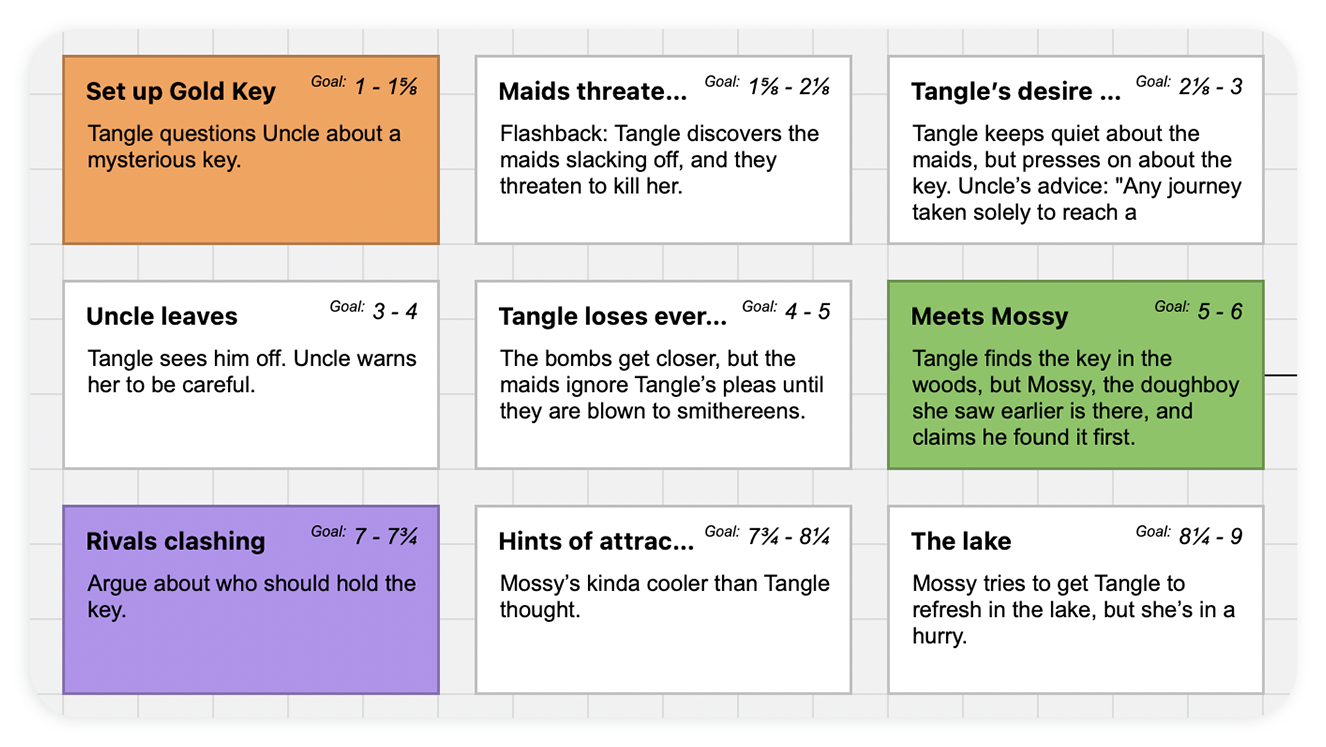Structure, Structure, Structure
November 21, 2024
Imagine a world without structure. The idea may be compelling to some rebels, but the reality is a nightmare.
Story Structure is Essential
In writing, there are two broad categories of people: Pantsers and Planners. The first group just writes ‘by the seat of their pants.’ The second plans. But even so-called planners go off-script, and pantsers use structure even if they don’t directly admit to it.
Tentpoles
Tentpoles, the building blocks of structure, provide a place to write to; what that writing is will be entirely up to the creativity of the writer. As any teacher quickly understands, even given the same tools, there is a vast difference between student works no matter what the student uses.
In the book “Quantum Scriptwriting”, structure is broken down thoroughly along with the reasons it’s used. The “Why” of structure is featured even more than the “What” - although all is covered.
Numerous examples are presented, and at least half the book is a scene-by-scene breakdown of the movie “Black Panther” which has a superb structure and an incredibly complex internal journey for a comic book character. The movie smacks of Shakespearean narrative ideas.
Let’s see how structure works.
A Famous Example
There is perhaps no more universally-known movie than “The Wizard Of Oz.” Considered to be in the top ten of many movie lists for the last several decades, it is also one of the easiest-to-understand examples of story tentpoles because of its simple road trip narrative paradigm, and milestone-based structure underlying the fantastical journey. We’ll be using it to illuminate structure concepts. Wizard also has solid themes and characters representing Dorothy’s subconscious mind.
Dorothy's Two Journeys
Well-conceived and well-written films have an A and B story. The A-story is the plot; the B-story is the emotional journey. Do one or the other right and chances are both will be well-served.
What’s not instantly apparent but important in Wizard is that Dorothy is an orphan. She’s living on a farm run by her aunt and uncle. This underlying issue leads her to wish for a place ‘over the rainbow.’ She feels unheard and under-appreciated. This longing will evolve into a true knowledge of what’s really important.
Wizard takes her on a journey of self-discovery, a trek to Oz that will help her to grow up and express appreciatively that: ‘there’s no place like home.’

In the A-story, Dorothy embarks on a road trip in Oz to Emerald City. Along the way she picks up various characters who reflect who she is and isn’t. These companions and their foibles, and the individual adventures show Dorothy valuable lessons that will bring her to the realization that she actually had a very beautiful life in Kansas and that she was wrong to run away ‘over the rainbow.’ That understanding (growth) becomes the B-story.
So, detailing with the journey (the A-story) also serves to complete the emotional B-story.
Tentpoles
In “Quantum Scriptwriting” seven major structure tentpoles are identified. Each tentpole connects linearly to the next tentpole in order.

Act I
Inciting Incident Tentpole
The first tentpole is the Inciting Incident. It creates the reason for the story.
Dorothy runs away from home because she fears for her dog, Toto’s, life. While outside the safety of the farm, a tornado springs up flinging her and Toto over the rainbow into Oz. The farmhouse Dorothy is in falls on the Wicked Witch of the East, killing her, and transferring the deceased witch’s ruby slippers to Dorothy’s feet, a symbol of the magical (dream) nature of Oz.
When the Wicked Witch of the West tries to get the slippers but cannot, she vows revenge. Glinda the good witch advises Dorothy to seek the Wizard of Oz’s help. “Follow the yellow brick road” to Emerald City to get back home.
Threshold Tentpole
Stepping onto the road to Emerald City ends Act I and starts Act II. Act II serves as a crucible for the character both physically and emotionally. It is usually a new arena of some sort.
In the “Quantum Scriptwriting” structure paradigm, Act II is broken into Act IIa and Act IIb. Each section serves a different purpose to the character and narrative thread. While Act IIa is somewhat benign, Act IIb is filled with much more severe trials.
Act II
Power Move by Protagonist Tentpole
The connecting tentpole between Threshold and Midpoint is a very good one in Wizard in that it provides the character with assets to succeed. In Dorothy’s case this is more than one asset. She already has Toto, but she picks up three staunch allies to help her on her journey: Scarecrow, Tin Man, and Lion.
Midpoint Tentpole
Midpoint is an apparent success. It is the positive pinnacle of the story so far but it is only temporary because the character still hasn’t really learned the lessons they need in order to change.
Dorothy and her team achieve Emerald City defeating several (soft) attempts to stop them. After being initially rebuffed she actually gains an audience with ‘the great and powerful Oz.’
All will be well now - she will go home and put this all behind her. But, it’s only an apparent success because-

Rug Pulling Tentpole
The RUG PULLING occurs directly after midpoint and starts Act IIb. Anything good that happened in Act IIa is basically invalidated in IIb and then a series of events that truly challenge the character begins.
Thinking she is home free (pun intended) Dorothy is unfortunately shocked to find out the Wizard has conditions. She has to get the witch’s broom.
Without any hope of success, against a more powerful opponent that could easily destroy her, Dorothy and the group head to the Witch’s lair, a dark and ugly place (hint, hint: subconscious) the Haunted Forest to get the Witch’s broom.
Power Move by Antagonist Tentpole
This tentpole is between Rug Pulling and Ego Destruction. In this case it is the flying monkeys who are sent to terrorize Dorothy and the others and kidnap Dorothy to the evil witch’s castle. The monkeys also destroy the scarecrow and hurt the team.
Ego Destruction Tentpole
Ego Destruction is the lowest point in the film where a character comes face-to-face with the consequences of their behavior.
After capture by the monkeys, the witch demands the ruby slippers to save Toto’s life. Despite being told by Glinda, the Good Witch, not to ever give up the slippers, Dorothy concedes. However, the slippers won’t come off Dorothy’s feet unless she’s dead. The Witch gives her mere hours to live.
Toto escapes which makes Dorothy happy but it also leaves her alone. She despairs and cries pitifully. All is seemingly lost.
Act III
After Toto leads the trio back to the Witch’s castle, Dorothy throws (cleansing) water on the Witch and melts her. The group heads back to Oz with the broom to claim the boon.
The Wizard again refuses to help. Toto pulls back the curtain and the Wizard is revealed to be a dowdy old man with some great special effects. He arranges for he and Dorothy to head back to Oz in a balloon but he leaves without her. This is really an essential part of the story because Dorothy discovers something important.
Glinda tells her she can find her way back, has always been able to go back by tapping her ruby slippers together and saying, “There’s no place like home. There’s no place like home.”
“The Wizard of Oz” is a fantastical adventure but also a coming-of-age film where Dorothy learns some lessons of adulthood. She has passed from being a child who feels under-appreciated to someone who now knows what’s really important, the value of family and gratitude.
Exercise: Take a few really well-done movies (“Arrival”, “Green Book”, “Hidden Figures”, and “CODA” all break down well) and break them down. Typical episode #1’s of TV series also are great to use. The series “Warrior” has a solid structure as does “Fallout,” and “A Good Girl’s Guide To Murder”.
Conclusion
Some endings are not redemption endings, i.e. the character never changes and/or dies, but 95% of movies and TV eps show the protagonist coming to terms with their character flaws and changing during their journey. In the case of a TV series the character can’t change completely. What would “Monk” be without its on-the-spectrum protagonist? But any character can learn small lessons each episode.
The structure paradigm here and in “Quantum Scriptwriting” is based on thousands of TV and film stories. It solves both The What and The Why of structure.
Once you apply this paradigm to stories you can see it being used everywhere.
Written by: Mark Sevi
Mark Sevi is a professional screenwriter, screenwriting teacher, and podcaster. He is the founder of the Orange County Screenwriters Association.



